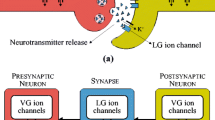Abstract
By injecting an electrical current control stimulus into a neuron, one can change its inter-spike intervals. In this paper, we investigate the time optimal control problem for periodically firing neurons, represented by different one-dimensional phase models, and find analytical expressions for the minimum and maximum values of inter-spike intervals achievable with small bounded control stimuli. We consider two cases: with a charge-balance constraint on the input, and without it. The analytical calculations are supported with numerical results for examples of qualitatively different neuron models.
Similar content being viewed by others
References
Ashwin P, Swift J (1992) The dynamics of N weakly coupled identical oscillators. J Nonlin Sci 2: 69–108
Benabid AL, Pollak P, Gervason C, Hoffmann D, Gao DM, Hommel M, Perret JE, Rougemont JD (1991) Long-term suppression of tremor by chronic stimulation of the ventral intermediate thalamic nucleus. Lancet 337: 403–406
Brown E, Holmes P, Moehlis J (2003) Globally coupled oscillator networks. In: Kaplan E, Marsden J, Sreenivasan K (eds) Perspectives and problems in nonlinear science: a celebratory volume in honor of Larry Sirovich. Springer, New York, pp 183–215
Brown E, Moehlis J, Holmes P, Clayton E, Rajkowski J, Aston-Jones G (2004) The influence of spike rate and stimulus duration on noradrenergic neurons. J Comp Neurosci 17: 13–29
Brown E, Moehlis J, Holmes P (2004) On the phase reduction and response dynamics of neural oscillator populations. Neural Comp 16: 673–715
Cohen A, Holmes P, Rand R (1982) The nature of coupling between segmental oscillators of the lamprey spinal generator for locomotion: a model. J Math Biol 13: 345–369
Danzl P, Hespanha J, Moehlis J (2009) Event-based minimum-time control of oscillatory neuron models. Biol Cybern 101: 387–399
Danzl P, Nabi A, Moehlis J (2010) Charge-balanced spike timing control for phase models of spiking neurons. Discrete Continuous Dyn Syst Ser A 28: 1413–1435
Ermentrout GB (1996) Type I membranes, phase resetting curves, and synchrony. Neural Comp 8: 979–1001
Ermentrout GB (2002) Simulating, analyzing, and animating dynamical systems: a guide to XPPAUT for researchers and students. SIAM, Philadelphia
Forger DB, Paydarfar D (2004) Starting, stopping, and resetting biological oscillators: in search of optimal perturbations. J Theor Biol 230: 521–532
Gerstner W, Van Hemmen L, Cowan J (1996) What matters in neuronal locking?. Neural Comp 8: 1653–1676
Ghigliazza RM, Holmes P (2004) A minimal model of a central pattern generator and motoneurons for insect locomotion. SIAM J Appl Dyn Syst 3(4): 671–700
Hansel D, Mato G, Meunier C (1993) Phase dynamics for weakly coupled Hodgkin–Huxley neurons. Europhys Lett 25(5): 367–372
Hansel D, Mato G, Meunier C (1995) Synchrony in excitatory neural networks. Neural Comp 7: 307–337
Hodgkin AL, Huxley AF (1952) A quantitative description of membrane current and its application to conduction and excitation in nerve. J Physiol 117: 500–544
Izhikevich EM (2007) Dynamical systems in neuroscience: the geometry of excitability and bursting. MIT Press, London
Keener J, Sneyd J (1998) Mathematical physiology. Springer, New York
Kirk DE (1970) Optimal control theory: an introduction. Dover Publications, USA
Kopell N, Ermentrout G (1990) Phase transitions and other phenomena in chains of coupled oscillators. SIAM J Appl Math 50: 1014–1052
Kuramoto Y (1984) Chemical oscillations, waves, and turbulence. Springer, New York
Lenhart S, Workman JT (2007) Optimal control applied to biological models. Chapman and Hall/CRC, London
Merrill D, Bikson M, Jefferys J (2005) Electrical stimulation of excitable tissue: design of efficacious and safe protocols. J Neurosci Methods 141(2): 171–198
Moehlis J, Shea-Brown E, Rabitz H (2006) Optimal inputs for phase models of spiking neurons. ASME J Comp Nonlin Dyn 1: 358–367
Nabi A, Moehlis J (2009) Charge-balanced optimal inputs for phase models of spiking neurons. In: Proceedings of the 2009 ASME dynamic systems and control conference, Hollywood, DSCC2009-2541
Nabi A, Moehlis J (2010) Nonlinear hybrid control of phase models for coupled oscillators. In: Proceedings of the 2010 American control conference, Baltimore, pp 922–923
Pare D, Curro’Dossi R, Steriade M (1990) Neuronal basis of the Parkinsonian resting tremor: a hypothesis and its implications for treatment. Neuroscience 35: 217–226
Revell VL (2005) How to trick mother nature into letting you fly around or stay up all night. J Biol Rhythms 20: 353–365
Rinzel J, Ermentrout GB (1998) Analysis of neural excitability and oscillations. In: Koch C, Segev I (eds) Methods in Neuronal Modeling. MIT Press, London, pp 251–291
Rose R, Hindmarsh J (1989) The assembly of ionic currents in a thalamic neuron I. The three-dimensional model. Proc R Soc Lond B 237: 267–288
Shaik OS, Sager S, Slaby O, Lebiedz D (2008) Phase tracking and restoration of circadian rhythms by model-based optimal control. Syst Biol IET 2: 16–23
Tass PA (1999) Phase resetting in medicine and biology. Springer, New York
Winfree A (2001) The geometry of biological time, 2nd edn. Springer, New York
Author information
Authors and Affiliations
Corresponding author
Additional information
This work was supported by the National Science Foundation Grant NSF-0547606 and 1000678.
Rights and permissions
About this article
Cite this article
Nabi, A., Moehlis, J. Time optimal control of spiking neurons. J. Math. Biol. 64, 981–1004 (2012). https://doi.org/10.1007/s00285-011-0441-5
Received:
Revised:
Published:
Issue Date:
DOI: https://doi.org/10.1007/s00285-011-0441-5




